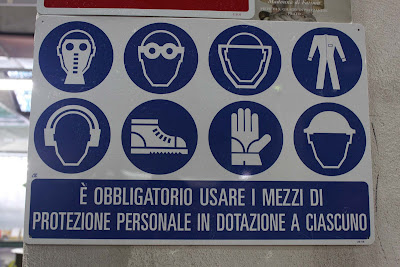This school year at Politecnico di Milano is focused on knitwear. We learn to knit on the machines, design knitwear, make patterns for stretch fabrics and drape with stretch fabrics. The machines are manual so we have to thread them, then move the carriage from left to right over and over while changing settings and such. And if one little mistake happens, the whole thing unravels. It is very satisfying once you get the hang of it, but so far, more often than not, it is quite frustrating. In the photo below, it looks like I'm a pro but I'm actually in the midst of saying, "Wait, wait, I'm not ready. I lost a stitch."
This is the setup of the macchina maglieria. We put the cones of yarn on the floor and thread the yarn through the wires above the machine. The yarn can be a combination of two or three yarns to create a different thickness or color combination. Then the yarn is loaded into the carriage, pictured on the left below. The needles are put into the correct position, depending on the pattern, and the carriage is moved across to thread the needles. A comb is then inserted from the bottom to hold the stitches and then the carriage is pushed from side to side until the sample reaches the correct length. The comb is the metal piece with the holes and the black weight hanging from the bottom.
Below, the sample is in the process of being cast-off, which is done by hand, with the tool in the first photo, which moves each stitch, one by one.
Below is my first complete sample. The yellow yarn at the top is the waste yarn that gets removed at the end. I have about a million more samples to do before the semester ends.
Outside the school with my Magnum Gold ice cream bar (painted with gold butterscotch!), perche devo avere dolce dopo il mio pranzo. That means "because I must have dessert after my lunch." Actually I must have dessert after every meal and for breakfast as well. Nutella happens to be the national breakfast of Italy, says it right on the label.



































































































